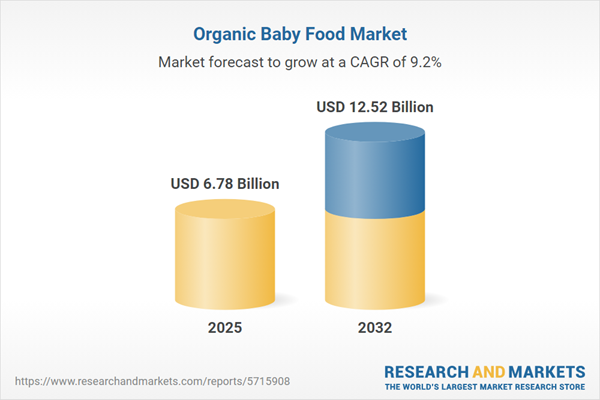Speak directly to the analyst to clarify any post sales queries you may have.
The organic baby food market is evolving rapidly, shaped by shifting regulations, intensified calls for transparency, and growing emphasis on sustainable business practices. Senior decision-makers are navigating a dynamic environment where compliance, innovation, and supply chain agility are essential for maintaining competitive advantage.
Market Snapshot: Organic Baby Food Market Size and Growth Outlook
The organic baby food market is poised for robust growth, with revenue projected to rise from USD 6.21 billion in 2024 to USD 6.78 billion in 2025, ultimately reaching USD 12.52 billion by 2032 at a CAGR of 9.15%.
This surge is intensifying the demand for traceable, clean-label products, prompting significant investment in resilient supply chains, digital transformation, and stringent ingredient verification. Leading brands respond by integrating certified non-GMO ingredients, refining traceability platforms, and transitioning to sustainable operations. These shifts reinforce long-term regulatory alignment and sustainability commitments across the global market.Scope & Segmentation: Comprehensive Analysis of the Organic Baby Food Market
- Product Types: Includes baby cereals, snacks such as biscuits, crackers, puffs, dairy products like yogurt and cheese, and purees derived from a mix of fruits, vegetables, meats, and seafood. These products address a full spectrum of nutritional needs for infants and toddlers, catering to diverse dietary requirements and preferences.
- Distribution Channels: Chain pharmacies, mainstream supermarkets, specialty retail outlets, and digital sales platforms create an omnichannel experience. This broad approach enables businesses to reach a wider customer base and respond quickly to evolving purchasing behaviors across physical and online channels.
- Age Groups: Solutions are tailored for infants aged 4–6 months and older toddlers, ensuring continuous nutritional support that corresponds with critical early growth milestones and emerging health trends among families.
- Packaging Types: Diverse options such as recyclable glass jars, flexible pouches, various plastics, and box formats all adhere to safety regulations while promoting environmentally responsible packaging, supporting both compliance and sustainability objectives.
- Regions: The Americas, Europe, Middle East & Africa, and Asia-Pacific each present distinctive regulatory and consumer landscapes, requiring region-specific strategies. Regulatory complexity, local consumer expectations, and unique retail models necessitate adaptable supply chains and tailored market approaches to bolster competitiveness and compliance.
- Leading Companies: Industry direction is shaped by players like Nestlé S.A., The Hain Celestial Group, Danone S.A., Campbell Soup Company, Sprout Foods, Hipp GmbH & Co., J.M. Smucker Company, Ella’s Kitchen Ltd., Bellamy’s Organic Pty Ltd, and Once Upon a Farm, Inc., who elevate ingredient verification standards, drive innovation, and emphasize sustainable sourcing and manufacturing.
- Technology Adoption: The implementation of digital traceability systems, advanced analytics for product and process refinement, enhanced communication tools, and environmentally responsible packaging innovations empower companies to adapt swiftly to new regulations and maintain operational transparency.
Key Takeaways for Senior Decision-Makers
- Third-party certification and rigorous ingredient transparency enhance brand trust and value across both digital and physical retail environments, making partnerships more robust and market entry more effective.
- Investing in sustainable packaging not only aligns with evolving regulatory landscapes but also demonstrates environmental responsibility, strengthening brand reputation and meeting stakeholder expectations.
- Building agile, collaborative relationships with regional supply partners ensures timely adaptation to shifting consumer demands and regulatory requirements in various markets.
- Integrating operations between suppliers and manufacturers supports rapid development of specialized dietary solutions and strengthens risk management protocols, delivering added value to buyers.
- Leveraging data-driven insights allows executive teams to respond efficiently to changing consumer preferences and optimize omnichannel strategies in increasingly complex retail environments.
- Maintaining interconnected, resilient supply chains underpins compliance, operational continuity, and the ability to absorb disruptive challenges within the evolving organic baby food sector.
Tariff Impact: Assessing the 2025 US Tariff Environment
Recent US tariffs on imported organic baby food are influencing procurement, logistics, and sourcing strategies. Market participants are reducing exposure to uncertainty by diversifying supply chains, prioritizing domestic sourcing, and accelerating risk assessments. Adjustments in distribution methods and early risk detection are central for ongoing regulatory compliance and uninterrupted operations in the current tariff environment.
Methodology & Data Sources
This report draws on direct interviews with senior stakeholders, in-depth secondary source evaluation, and rigorous data modeling. Every conclusion has been cross-validated through triangulation to ensure objective, reliable findings for executive stakeholders.
Why This Report Matters
- Provides executive teams with decision-ready insights to guide resource allocation and forge strategic partnerships aligned with prevailing and anticipated industry trends.
- Equips organizations with frameworks for effective scenario planning and compliance management, enabling continued market relevance and organizational resilience.
- Supports organizational oversight of regulatory and operational processes, fostering confidence with both internal leadership and key external partners.
Conclusion
Senior decision-makers can leverage these insights to navigate regulatory shifts, align organizational strategies with sector priorities, and reinforce operational resilience while the organic baby food sector continues to advance in complexity.
Additional Product Information:
- Purchase of this report includes 1 year online access with quarterly updates.
- This report can be updated on request. Please contact our Customer Experience team using the Ask a Question widget on our website.
Table of Contents
3. Executive Summary
4. Market Overview
7. Cumulative Impact of Artificial Intelligence 2025
Companies Mentioned
The companies profiled in this Organic Baby Food market report include:- Nestlé S.A.
- The Hain Celestial Group, Inc.
- Danone S.A.
- The Campbell Soup Company
- Sprout Foods, Inc.
- Hipp GmbH & Co. Vertrieb KG
- The J.M. Smucker Company
- Ella’s Kitchen Ltd.
- Bellamy’s Organic Pty Ltd
- Once Upon a Farm, Inc.
Table Information
| Report Attribute | Details |
|---|---|
| No. of Pages | 184 |
| Published | October 2025 |
| Forecast Period | 2025 - 2032 |
| Estimated Market Value ( USD | $ 6.78 Billion |
| Forecasted Market Value ( USD | $ 12.52 Billion |
| Compound Annual Growth Rate | 9.1% |
| Regions Covered | Global |
| No. of Companies Mentioned | 11 |









